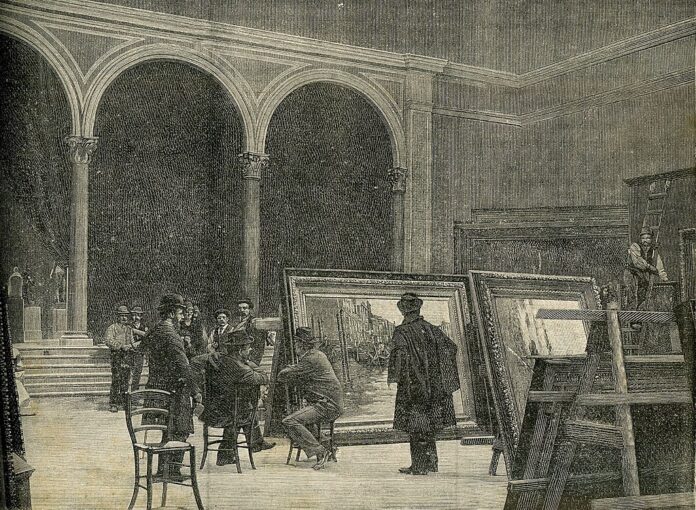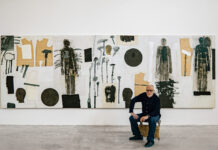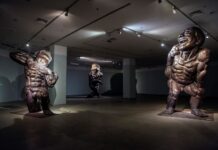We have not yet visited the Biennale, so we will avoid making any expert judgements, since they might well be considered unfashionable by many readers.
The spark that Adriano Pedrosa, director of the São Paulo Museum, and now curator of Biennale Arte 2024, has put into this Venice project is certainly engaging. Not least because it is inspired by the kind of spark associated with the Claire Fontaine collective (these groups are both involved in this exhibition project). A somewhat enigmatic Duchampianly-playful title encompasses the work of two artists of a certain ingenuity, Palermo-born Fulvia Carnevale and the Parisian James Thornhill. A collective based in two countries, Italy and France, but actually stateless from and operational/mental viewpoint. I soon became aware of their ingenuity, design initiative focused on social issues (including feminism) and their ability to make an impact on the cityscape, especially the suburbs, when I attended a three-day conference on ‘Peripheral Living’ (coordinated, for the Faculty of Architecture in Syracuse, by my colleague Zaira Dato) that featured an exhibition that Silvana Segapeli had dedicated to Claire Fontaine.
As an expert in environmental art, I really admired their work. I was equally impressed with Fulvia Carnevale, who gave a speech shortly after my opening presentation. Subtle, witty, eloquent and, above all, with clear ideas about ‘concrete’ art, ‘public art’, which is especially widespread in the USA. It was March 2008 and Claire Fontaine was just four years old.
I am not surprised, therefore, that the Brazilian artist Adriano Pedrosa, who has lived his life in the suburbs, should draw inspiration from a key work by Claire Fontaine for his entire project of a fundamentally sociological nature. And he really delivers on its title: ‘Strangers Everywhere’. It will certainly have the blessing of the new president of the Biennale (who is about to take office), Pietrangelo Buttafuoco, both because he is a brilliant and inventive intellectual and also because he has a fine grasp of social issues.
Foreigners Everywhere. In May 2023 at the Ecomuseo Mare Vivo in Palermo, as part of the Vesak celebrations, the Claire Fontaine collective created this large installation, a big work on many levels. It is focused on: reception and immigration. Fulvia Carnevale emphasised a reversal in sociological visions from the geographical to the behavioural and sentimental. For her it is really ‘we are foreigners wherever we go, and also we meet foreigners wherever we go’. And she again emphasises their (the collective’s) interest in ‘new welcoming strategies that identify with foreigners and not with the people who welcome them’. In short, a ‘stimulating notion of foreignness’.
Pedrosa’s muse attaches great importance to this social commitment given that “the climate crisis will inevitably lead to great migrations and displacements of refugees”; the curator, the first Latin American to head the Venice Art Biennale, on one hand makes this thought of Carnevale’s his own, and on the other hand adds a very personal note: “regardless of your location, deep down you are always really foreign”.
Pedrosa moves on from this geopolitics of art to more temporal thinking about the issue of ‘global modernism’ connected with the advance of the global south. The crux of the matter is quite plausible. Among other things, it reminds me of my own personal experience at an exhibition entitled ‘The South of the World/alternative contemporary art’ that I curated in Marsala and Palermo in 1991 with the help of various commissioners (including: Jorge Glusberg, Wijdan Ali, Amnon Barzel, Pierre Restany).
I entitled my introductory essay to the catalogue (Gabriele Mazzotta Editore) “The New Philosophy of the Cardinal Points” (Moreover, shortly afterwards, Achille Bonito Oliva paraphrased this title into “Cardinal Points of Art” for the 19993 Biennale). I noted, among other things, that “The South of the World is not an antagonistic force to the North, it simply constitutes otherness, diversity. The north and south are reciprocally the backdrop against which the other stands out’ (p.21). Pedrosa is quite right to emphasise these themes today, particularly bearing in mind the thoughts expressed by Hans-Georg Gadamer in the above-mentioned catalogue.
Here’s just one example: “…in a broader perspective, the future in my view will depend on the possible political and economic inclusion of hitherto marginal geo-political areas in a world system of equilibrium. If, in past decades, the famous continental balance was one of the aims of British policy, today, in contrast, this balance cannot but take on a global dimension and must necessarily include other countries and geographical areas’ (p.3). At one point Edgar Morin notes that “…at the very root of the notion of development, what might appear most affluent is actually poor: the idea of man and society. The idea of development has been founded on a one-dimensional and poor humanistic-rationalistic myth of man, and on an extraordinarily narrow-minded mechanistic-economistic idea of society’ (p. 9).
Pedrosa’s effort to address a socio-philosophical problematic like modernism at an art event is admirable. But attaching such a modern-day and much misused adjective as ‘global’ may not be enough to make it current or polysemantic or multidirectional. This is because it is an eminently Western concept that has provoked Eurocentric behaviour with all the consequences of colonisation. And I would not feel like telling an African, Chinese person or Arab that ‘you are the protagonist of a form of global modernism’.
This exhibition, which is likely to be enjoyable, will, in fact, distract us from this line of thinking but it might focus us on others. The visit will probably distract me from any kind of typological analysis encompassing the likes of ‘Portraits’, ‘Abstractions’. It will distract me, too, with the indigenous and authentic force of Maori or Singaporean works or the drive of Queer or Indigenous art, or even Outsider grouping. The latter, as Pedrosa puts it, “stands at the margins of the art world, just like self-taught or so-called Folk artists”. To consider the self-taught as being on the margins of the art world will force us to look with suspicion at many of those categories constituting the firmament of contemporary art.
Pedrosa pays homage to Italy through Marco Scotini’s intelligent travelling and changing exhibition project entitled ‘Disobedience Archive’ from 2005. This exhibition method inspires the Biennale’s “Nucleo Contemporaneo” being held at the Corderie, curated by Julian Ziebell and featuring works by artists (39) and collectives from 1975 to 2023. We will also see what surprises “Futuring Global Asias” will have in store among the side events. This is being promoted by two London institutions that have done plenty of work on this subject along the lines of equity, sustainability and democracy (Asymmetry Art Foundation and Forum Asia).
Biennale Arte Venezia
Non abbiamo ancora visitato la Biennale e quindi eviteremo di dare giudizi specialistici, per non dire che potrebbero essere considerati fuori moda, e non da pochi fruitori.
L’élan vital che Adriano Pedrosa, direttore del Museo di San Paolo, e ora curatore della Biennale Arte 2024, mette nel progetto lagunare è sicuramente coinvolgente. Anche perché si ispira all’ l’élan vital del collettivo Claire Fontaine (peraltro i gruppi sono ben in questo progetto espositivo). Sotto quel titolo un po’ enigmatico, duchampianamente giocoso, operano due artisti di sicuro ingegno, la palermitana Fulvia Carnevale e il parigino James Thornhill.
Un collettivo con doppio passaporto, italiano e francese, ma operativamente e mentalmente apolide. Del loro ingegno, della loro intraprendenza progettuale votata al sociale (femminismo compreso) e della loro capacità di incidere nel contesto urbano, specialmente periferico, mi resi subito conto nell’occasione di un incontro. Un convegno di tre giorni su Il vivere periferico (coordinato, per la Facoltà di Architettura di Siracusa, dalla collega Zaira Dato) era vivacizzato da una mostra che Silvana Segapeli dedicava a Claire Fontaine. Da specialista di arte ambientale l’apprezzai non poco. Ma non minore interesse mi provocò Fulvia Carnevale, col suo intervento, poco dopo la mia relazione di apertura. Sottile, arguta, dialettica sciolta, e soprattutto idee chiare in fatto d’arte “concreta”, “public art”, diffusa soprattutto in Usa. Era il marzo 2008, e Claire Fontaine era nato/a quattro anni prima.
Un titolo a contenuto sociale per la Biennale Arte 2024
Non mi fa specie, quindi, che l’agile brasiliano Adriano Pedrosa, che di periferia si intende per vita vissuta, per l’intero suo progetto a carattere fondamentalmente sociologico tragga ispirazione da un cruciale lavoro di Claire Fontaine. E ne rispetti pienamente il titolo: “Stranieri ovunque”. Avrà certamente la benedizione del nuovo presidente della Biennale (che sta per insediarsi), Pietrangelo Buttafuoco: sia perché brillante e inventivo intellettuale, sia perché di fenomeni sociali si intende bene.
Foreigners Eveywhere. Nel maggio 2023, a Palermo, all’Ecomuseo Mare Vivo, nell’ambito delle celebrazioni Vesak, il collettivo Claire Fontaine realizza questa grande installazione, tale non solo con riguardo alle sue dimensioni spaziali. Al centro: accoglienza e immigrazione. Fulvia Carnevale ha avuto modo di sottolineare un capovolgimento della visione sociologica dal dato geografico a quello comportamentale e sentimentale. Infatti, per lei “stranieri siamo ovunque andiamo, e stranieri incontriamo ovunque andiamo”. E sottolinea ancora il loro interesse (del collettivo) per “nuove strategie di accoglienza che si identifichino con gli stranieri e non col popolo che li accoglie”. Insomma, una “estraneità stimolante”.
Impegno sociale
La musa di Pedrosa dà grande importanza a questo impegno sociale, dato che “l’emergenza climatica porterà anche a grandi migrazioni e spostamenti di rifugiati”; il curatore, primo latino-americano a capo della Biennale Arte di Venezia, per un verso fa suo questo pensiero della Carnevale, per altro verso aggiunge una nota soggettivistica: “a prescindere dalla propria ubicazione, nel profondo si è sempre veramente stranieri”.
Da questa geopolitica dell’arte, Pedrosa passa a una riflessione temporale, la tematica del “modernismo globale” connesso con l’avanzare del sud del mondo. Il nocciolo della questione è ben plausibile. Tra l’altro, mi fa ricordare un’esperienza personale, la mostra “Il sud del Mondo/ l’altra arte contemporanea” che curavo tra Marsala e Palermo nel 1991 con il contributo di vari commissari (Jorge Glusberg, Wijdan Ali, Amnon Barzel, Pierre Restany, e altri). Intitolavo il mio saggio introduttivo al catalogo (Gabriele Mazzotta Editore) “La nuova filosofia dei punti cardinali” (Peraltro, poco dopo, Achille Bonito Oliva -per la Biennale del 1993 parafrasava quel titolo con Punti cardinali dell’arte”).
Rilevavo, tra le altre cose, che “Il Sud del Mondo non è una forza antagonista del Nord, ma semplicemente costituisce l’alterità, la diversità. Il Nord e il Sud sono scambievolmente l’uno il fondale contro il quale risalta l’altro” (p.21). Tanto più ha ragione Pedrosa di enfatizzare queste tematiche oggi, quanto più si tengano presenti le riflessioni di Hans-Georg Gadamer, nel catalogo citato. Un solo esempio: “…in una prospettiva più ampia, il futuro a mio avviso dipenderà dal possibile inserimento politico ed economico di aree geo-politiche fino ad ora marginali in un sistema mondiale di equilibrio.
Se, nei decenni passati, il famoso equilibrio continentale era uno dei fini della politica britannica, oggi, invece, questo equilibrio non può non assumere una dimensione mondiale e deve comprendere necessariamente altri paesi e aree geografiche” (p.3). Nella stessa sede, Edgar Morin a un certo punto rileva che “…alla radice stessa della nozione di sviluppo, quel che sembra più ricco è in realtà povero: l’idea dell’uomo e della società. Si è fondata l’idea di sviluppo su un mito umanistico-razionalistico unidimensionale e povero dell’uomo, e su un’idea meccanicistico-economicistica della società straordinariamente ristretta” (p. 9).
Apprezzabilissimo lo sforzo di Pedrosa di affrontare, nella circostanza di un evento d’arte, una problematica socio-filosofica, quale è il modernismo. Ma forse non basta affibbiare a questo termine, spesso anche abusato, un aggettivo di oggi – globale – per renderlo attuale o polisemantico o pluridirezionale. Questo perché si tratta di un concetto eminentemente occidentale che ha provocato comportamenti eurocentrici con conseguenze di colonizzazione. E non mi sentirei di dire a un africano o a un cinese o a un arabo “tu sei protagonista di un modernismo globale”.
Ma la mostra, verosimilmente godibile, ci distrarrà da questi pensieri. Magari ce ne provocherà altri. Probabilmente la visita mi distrarrà da una ripartizione tipologica che comprende “Ritratti”, “Astrazioni”. Mi distrarrà, anche, a causa della forza autoctona e autentica dei Maori o di opere di Singapore o della pulsione del raggruppamento dei Queer, o degli indigeni, o degli outsider. L’outsider, come dice Pedrosa, “si trova ai margini del mondo dell’arte, proprio come l’autodidatta o i cosiddetti artisti Folk”. Un po’ forte, credo, il riferimento all’autodidatta. Considerare l’autodidatta (cioè colui che ha avuto la capacità di essere self-taught) come uno ai margini del mondo dell’arte, ci costringerebbe a guardare con sospetto tanti nomi che compongono il firmamento dell’arte contemporanea. Ma probabilmente si tratta di un problema di traduzione.
Pedrosa, omaggio all’Italia con un progetto itinerante
Pedrosa rende omaggio all’Italia con un altro ancoraggio: all’intelligente progetto di mostra itinerante e cangiante Disobedience Archive di Marco Scotini, a partire dal 2005. Questa metodologia espositiva ispira il “Nucleo Contemporaneo” della Biennale, alle Corderie, con la cura di Julian Ziebell e con opere di artisti (39) e collettivi dal 1975 al 2023. Stiamo a vedere, poi, quali sorprese riserverà, fra le iniziative collaterali, Futuring Global Asias promossa da due istituzioni londinesi ben attive nel tema con impegno nell’equità, sostenibilità, democrazia (Asymmetry Art Foundation e Forum Asia).
A shared article, a collaboration between FYINpaper and L’Arca International n. 178 (05-06, 2024).





